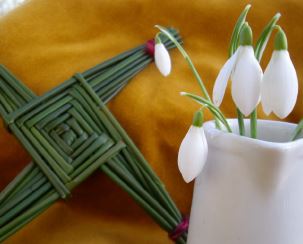
These stories about Brigit and the rituals that celebrate her feast day on 1st February were compiled to help you to come to a deeper understanding of who this holy woman was and how she has been portrayed in the ancient and not-so-ancient literature. It is my hope that by reading these simple texts, either alone or with a group, you might discover an aspect of Brigit that will resonate with your own life. The stories are arranged around nine of Brigit’s symbols: cross, fire, sword, cow, cloak, oak tree, snowdrop, dandelion and bell. You are invited to read the texts around a specific symbol and take some time to treasure the words in your heart. Then, either alone or in a group, reflect on the readings by noting whatever might have surprised you, struck you as interesting or strange, or simply delights you! After some discussion and/or meditation, you might want to then draw, write, sing, dance or dramatise whatever you discovered in these deceptively simple, yet profound stories.
Many blessings to you and I hope you enjoy your own inner discovery with Brigit as your guide.
Catherine Ann Lombard
Gronau
Germany
Cross
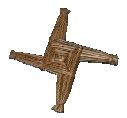
(All the testimonies below are taken from ‘St. Brigid’s Crosses’ by John C. O’Sullivan)
When the cross was made, the head of the house went round the house with it and placed it in every window and door round the house and said at each entrance or window – ‘St. Brigid save us from all fever, famine and fire’. He then came in and placed the cross over the kitchen door. – Co Leitrim
Very long ago (about 100 years ago) a cross was nailed up to the rafter and left there for a year; some left it seven years and others never took it down at all. You would know the age of the house that time by counting the crosses. – Co Sligo
Two plaits are made of the straw and they are fixed in the form of a cross. Then a good potato is got and pierced right through with a scallop and then the scallop with the potato on it is put through the centre of the cross. The cross is then stuck in the thatch until the time for the sowing of the oats. The oat seed is then taken from the St. Brigid’s cross and mixed with hen dung and holy water and a grain of salt and all are put in the bag with the seed that is to be sown. The seed taken from the cross is thus the first to be shaken. On Good Friday the potato is taken from the cross of St. Brigid and that is the first slit that is sown on that day, being also the first seed potato for the year. – Co Roscommon
These crosses were treated with great respect by all the people of the house. When they got old and faded and began to fall to pieces they were taken down. They were then rubbed between the palm of the hands and made into dust. Sometimes they were burned on an old iron cover. Then the dust was gathered and scattered over the land n order to bring St. Brigid’s blessing on the crops that would be planted that year. – Co Cork
Rushes left over from the making of the crosses were burned under the noses of sick cows as a cure. Some people before retiring on St. Brigid’s eve tied rushes left over from the making of crosses around their heads or other parts of the body subject to pains. In some parts, material left over from the making of the crosses was laid out as a bed on which it was hoped St. Brigid would rest during the night. This was known as ‘St. Brigid’s Bed’.
The ashes of old crosses which were buried were retained as they were reputed to have curative powers which would be applied to both animals and humans. – Co Donegal
Fire

One day in that place, Broicseach (Brigit’s mother who was a slavewoman) went to milk and she leaves nobody in her house except the holy girl who was asleep. They saw that the house had caught fire behind them. The people run to its aid, thinking that they would not find one house post against another. The house is found intact and the girls asleep. And Brigit is revered there as long as it may exist. – Betu Brigte, ed. D. O’hAodha
The Druid and the female slave and her child were at Loch Mescae and the Druid’s mother’s brother was there too; the latter was a Christian. When they were there at midnight the Druid was watching the stars and he saw a fiery column rising out of the house, from the precise spot where the slave and her daughter were. He woke his mother’s brother and he saw it also, and the latter said that she was a holy girl. ‘That is true‘, he said, ‘if I were to relate to you all her deeds’. – Betu Brigte, ed. D. O’hAodha
The hour of consecration having arrived, the veil was raised by angels from the hand of MacCaile, the minister, and is placed on the head of Saint Brigit. Bent down moreover during the prayers, she held the ash beam which supported the altar. It was afterwards changed into acacia, which is neither consumed by fire nor does it grow old through the centuries. Three times the church was burned down, but the beam remained intact under the ashes. – Betu Brigte, ed. D. O’hAodha
The Bishop being intoxicated with the grace of God did not recognise that he was reciting from his book, for the consecrated Brigit with the orders of a Bishop. ‘This virgin alone in Ireland’, said Mel, ‘will hold the Episcopal ordination’. While she was being consecrated a fiery column ascended from her head – Betu Brigte, ed. D. O’hAodha
On another day the Druid and the slavewoman were sitting in a certain spot with others in their company and suddenly they saw the ribbon round the little girl’s head burst into flame, and as they rushed to her reaching out their arms, they saw no fire at all! – The Christian Druids, J. Minahane
Brighde’s temple in Ireland was in Kildare. Here, within a circular enclosure, lived a community of virgin priestesses who guarded and kept alight a sacred flame, which was reputed to be ashless; it was believed that the ashes miraculously vanished. The circle was absolutely forbidden by men, and to this end was surrounded by a high hedge of thorns or wattles. Six, thirteen or nineteen women tended the flame. – Brighde, Her History, Folklore and Mythology, J.E. McCrickard
Sword
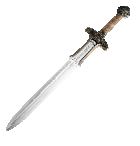
On one occasion, Dubthlach (Brigit’s father) brought Brigit to the King of Leinster, namely Dúnlang, to sell her as a serving slave, because her stepmother had accused her of stealing everything in the house for clients of God. Dubthach left her in his chariot to mind it on the green of the fort and he leaves his sword with her. She gave it to a leper who came to her. Dubthach said to the King: ‘Buy my daughter from me to serve you, for her manners have deserved it’. ‘What cause of annoyance has she given’? said the King. ‘Not hard’, siad Dubthach. ‘She acts without asking permission, whatever she sees, her hand takes’. Dubthach on returning, questions her about that precious sword. She replied: ‘Christ has taken it’. Having learned that, he said, ‘Why daughter, did you give the value of ten cows to a leper? It was not my sword, but the King’s’. The girl replied, ‘Even if I had power to give all Leinster, I would give it to God’. For that reason the girl is left in slavery. Dubthach returned to his home. Wonderful to relate, the virgin Brigit is raised by divine power and placed behind her father. ‘Truly Dubthach’, said the King, ‘this girl can neither be sold nor bought’. Then the King gives a sword to the virgin. – Betu Brigte, ed. D. O’hAodha
Cow
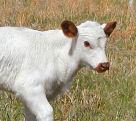
When it was time to wean her the Druid was anxious about her, anything he gave her to eat she vomited at once, but her appearance was none the worse. ‘I know’, said the Druid, ‘what ails the girl, it is because I am impure’. Then a white red-eared cow was assigned to sustain her and she became well as a result.
A woman from Fid Eoin who was a believer gave her a cow on that Easter Day. There were tow of them driving the cow, namely the woman and her daughter. They were not able, however, to drive their cows. They had lost their calf as they were coming through the wood. They besought Brigit then. That prayer availed them; their cow leads the ways before them to the settlement where Brigit was. ‘This is what we must do’, said Brigit to her maidens, ‘for this is the first offering made to us since occupying this hermitage. Let it be taken to the Bishop who blessed the veil on our head’. ‘It is of little benefit to him’, said the maidens, ‘the cow without the calf’. ‘That is of no account’, said Brigit. ‘The little calf will come to meet its mother so that together they will reach the enclosure’. It was done thus as she said.
On the following day, Tuesday, there was a good man nearby who was related to Brigit. He had been a full year ailing. ‘Take for me today’, said he, ‘the best cow in my byre to Brigit, and let her pray to God for me, to see if I shall be cured’. The cow was brought, and Brigit said to those who brought it: ‘Take it immediately to Mel (the priest)’. They brought it back to their house and exchanged it for another cow unknown to their sick man. That was related to Brigit, who was angry at the deceit practiced on her. ‘Between a short time from now and the morning’, said Brigit, ‘wolves shall eat the good cow which was given into my possession and which was not brought to you’, said she to Mel, ‘and they shall eat seven oxen in addition to it’. That was related then to the sick man. ‘God’, said he, ‘take to her seven oxen of the choice of the byre’. It was done thus. ‘Thanks be to God’, said Brigit. ‘Let them be taken to Mel to his church. He has been preaching and saying Mass for us these even days between the two Easters; take a cow each day to him for his labour, it is not greater than what he has given, and take a blessing with all eight cows, a blessing on him from whom they were brought’, said Brigit. When she said that, he was healed immediately. – Betu Brigte, ed. D. O’hAodha
From the cathedral tower, one an look over the far-famed Curragh, six miles long and two in width, supposed to be St. Brigid’s pasture ground, and therefore, never broken by the plough; giving a right of pasturage to those around its borders, because the saint would never exclude the cattle of her neighbours. – Some Account of Brigid, W. Sherlock, MA
Cloak
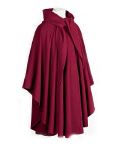
Condla, Brigit’s craftsman, attempted to go to Rome. Brigit had given his hooded garment to a leper in his absence when he was ringing the bell and Brigit was guarding his workshop. Condla ask Brigit for his garment and Brigit enquired of Rónchenn – a sub deacon who always minded her clothes – whether he had raiment. ‘Let you pray’, said he, ‘and there shall be some’. She prayed afterwards, and a garment was found in Rónchenn’s casket. Condla set out afterwards to go to Rome. She said to him: ‘Neither will you reach tither nor will you return hither’. And thus it happened, i.e. wolves ate him at Seé Congaill in the east of Mag Lifi.
Brigit comes to the west of Kildare to meet Brendan, having been instructed by an angel. She welcomes him at Lía Brénaind, and they go afterwards to Kildare. Now Brigit puts her wet hooded garment on the sun beams. Brendan’s boy puts the cloak which Brendan wore on them, but it fell down. He put it on them again, but they did not hold it up. Brendan himself arose and arranged it on them, and it remained thus. – Betu Brigte, ed. D. O’hAodha
Brigit’s cloak was known for its miraculous powers. When St. Brigit asked the King of Leinster to grant her land to establish her community, he said she could have as much land as her cloak could cover. Brigit eremoved her cloak and as she laid it on the earth, it unrolled and spread until it covered a large part of the area known as the Curragh of Kildare! – Celebrating Irish Festivals, Ruth Marshall
The Brat Bride refers to come article of clothing such as a cloak, jacket, belt or even a pair of braces or a ribbon or piece of cloth was left outside every Irish household – fastened to a windowsill, laid on the doorstep, or thrown across a low roof on the eve of the feast and taken inside the home the following day. In some places it was usual to fasten it to the door catch so that Brighde would be bound to touch it as she came in. Thus the cloth was imbued with Brighde’s healing power which could be transmitted to the sick or help with a difficult childbirth. – Brighde, Her History, Folklore and Mythology, J.E. Crickard
Oak Tree
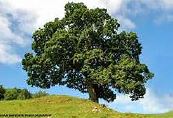
Being besought by the people of Leinster to return to them, Brigit fixed upon Drum Criash, the ridge of clay. There under a great oak tree, which she loved, she built her cell, round which were gathered the wattled huts of her community. Hence came the name Cil-dara, or Kildare, the cell of the oak. – Some Account of Brigid, W. Sherlock, M.A.
By Christian time, the nuns of Kildare were feeding the sacred fire with oak branches. – Brighde, Her History, Folklore and Mythology, J.E. Crickard
Snowdrop
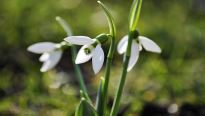
The snowdrop appears around about Brighde’s Feast Day and thus is dedicated to her under the name ‘Fair Maids of February’. The triple form of the flower gives the clue to her connection to Brighde. At the Brighde’s Eve rites, this was one of the blossoms used to decorate the images of the goddess, and probably, in consequence of this, it used to be taboo to bring snowdrops into the house.
Snowdrops were regarded by the ancients as a kind of panacea, but they are poisonous and should only be used by amateur herbalists for external treatments. The ointment made from the bulbs is used for frostbite and chilblains, and by an odd coincidence an extract of the bulbs is employed in modern medicine to treat the eye complaint, glaucoma.
Snowdrop is not native to Ireland, but comes from Austria and Switzerland and the plants were apparently introduced to the island by the Celts themselves. The Druids held it sacred and planted it in their holy groves of oak trees. – Brighde, Her History, Folklore and Mythology, J.E. Crickard
Dandelion

A herb sacred to Brighde in the Scottish Highlands and Islands was the humble dandelion Bearnan Bride, ‘Little notched of Brighde’, a reference to the serrated leaves. Its milky sap was believed to nourish the young lambs in February, while its diuretic properties were known to the Gaelic herb women. But its flowers give the real clue to its connection with Brighde, for they are first of all like blazing suns, and later the round white seed head resembles the full moon. Such a dual solar/lunar plant was particularly appropriate to Brighde. – Brighde, Her History, Folklore and Mythology, J.E. Crickard
Bell
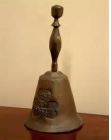
Celtic holy men and women often carried a handbell. That purportedly belonging to Brighde was forges for her by Saint Gildas at Glastonbury. Soon afterwards during her visit to a community of nuns at Beckery, she left her hood, scrip (food bag), a necklace or rosary, her weaving or embroidery kit and this bell behind. All was destroyed except the bell, which now is in the British Museum. – Brighde, Her History, Folklore and Mythology, J.E. Crickard
References
Betu Brigte, ed. Donncha Ó hAodha. Dublin: Institute for Advanced Studies, 1978
McCrickard, J.E., Brighde, Her History, Folklore and Mythology, Glastonbury, Sommerset: Fieldfare Arts & Design, 1987
Marshall, R., Celebrating Irish Festivals, Calendar of seasonal celebrations. Stroud, Gloustershire, UK: Hawthorn Press, 2003
Minahane, John, The Christian Druids, on the filid or Philosopher Poets of Ireland. Dublin: Howth Free Press, 2008
O’Sullivan, J.C., ‘St Brigid’s Crosses’, Folklife (11), 1973, pp 60 – 81
Sherlock, W., M.A., Some Account of Brigid and of the cathedral now restored. Dublin: Hodges, Figgis & Co. Limited, 1896


